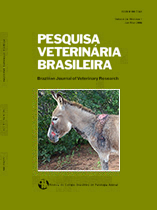 |
|
|
|
Year 2014 - Volume 34, Number 12
|

|
Analysis of hematologic and serum chemistry values of Spheniscus magellanicus with molecular detection of avian malarial parasites (Plasmodium spp.), 34(12):1236-1242
|
ABSTRACT.- Campos S.D.E., Pires J.R., Nascimento C.L., Dutra G., Torres-Filho R.A., Toma H.K., Brener B. & Almosny N.R.P. 2014. Analysis of hematologic and serum chemistry values of Spheniscus magellanicus with molecular detection of avian malarial parasites (Plasmodium spp.). Pesquisa Veterinária Brasileira 34(12):1234-1240. Departamento de Patologia e Clínica Veterinária, Faculdade de Veterinária, Universidade Federal Fluminense, Rua Vital Brazil Filho 64, Vital Brazil, Niterói, RJ 21230-360, Brazil. E-mail: s.destri@gmail.com
Magellanic penguins (Spheniscus magellanicus) routinely migrate from their breeding colonies to Southern Brazil often contracting diseases during this migration, notably avian malaria, which has been already reported in Brazil and throughout the world. Detection of Plasmodium spp. in blood smears is the routine diagnostic method of avian malaria, however it has a low sensitivity rate when compared to molecular methods. Considering the negative impact of avian malaria on penguins, the aim of this study was to detect the presence of Plasmodium spp. in Magellanic penguins using Polymerase Chain Reaction (PCR) and by verifying clinical, hematological, and biochemical alterations in blood samples as well as to verify the likely prognosis in response to infection. Blood samples were obtained from 75 penguins to determine packed cell volume (PCV), red blood cell (RBC) and white blood cell (WBC) counts, mean corpuscular volume (MCV), uric acid, total protein, albumin, globulin and aspartate aminotransferase (AST) activity levels. Whole blood samples were used for PCR assays. Plasmodium spp. was detected in 32.0% of the specimens using PCR and in 29.3% using microscopic analyses. Anorexia, diarrhea and neurological disorders were more frequent in penguins with malaria and a significant weight difference between infected and non-infected penguins was detected. PCV and MCV rates showed no significant difference. RBC and WBC counts were lower in animals with avian malaria and leukopenia was present in some penguins. Basophil and lymphocyte counts were lower in infected penguins along with high monocyte counts. There was no significant difference in AST activities between infected and non-infected animals. There was a significant increase in uric acid values, however a decrease in albumin values was observed in infected penguins. Based on this study, we concluded that Plasmodium spp. occurs in Magellanic penguins of rehabilitation centers in Southeastern Brazil, compromising the weight of infected animals with clinical alterations appearing in severe cases of this disease. It was also noted that, although the hematological abnormalities presented by these animals may not have been conclusive, leukopenia, monocytosis and the decrease of basophils and lymphocytes revealed an unfavorable prognosis, and Plasmodium spp. infections may progress with elevated uric acid concentration and low albumin levels. |
| |
|
|
| |
|
 |